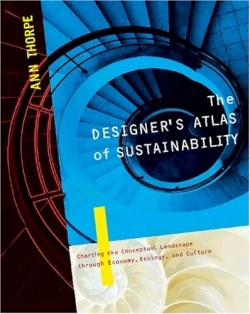The Designer's Atlas of Sustainability
Charting the Conceptual Landscape through Economy, Ecology, and Culture
Between hybrid cars, organic cotton t-shirts, and energy efficient light bulbs, it’s clear the environment is increasingly on people’s minds—not least for those who design these eco-items. In this useful new book, Thorpe, a senior lecturer in design at the Surrey Institute of Art and Design, has compiled a superb primer on the conceptual principles behind the sustainability movement so that all designers—whether they’re working on buildings, cars, or ads—can help society move toward a sustainable future by implementing “environmental and social conditions that will support human well-being indefinitely.”
The book is conceptualized as a type of atlas, or reference book, with bite-size chapters organized under three main section headings: ecology, economy, and culture. Thorpe envisions her target audience as consisting primarily of professional designers, and as a result, the book has a graphically fresh layout that is brimming with colorful images, tables, graphs, and informational boxes that summarize and elaborate upon the subject at hand, venturing into definitions of terms like “bioregion” or explanations of movements like the slow food movement. At the conclusion of each section there is a helpful pictorial overview of the material covered, highlighting that section’s main ideas and therefore touching on topics as diverse as renewable materials, the values of the nonprofit sector, or the way that contemporary artifacts are built for only short-term durability. Both the veteran eco-designer and the average reader will easily be able to dip in and out of the book.
Thorpe is the founding editor and publisher of On the Ground: Multimedia Journal on Community, Design, and Environment and in The Designer’s Atlas of Sustainability she has pulled together a handy and wide-ranging resource that catalogs and illustrates the way environmental considerations could change the way people make and use objects—like the t-shirt that has been designed so that it never needs to be washed. The ecology section not only considers designers’ use of materials, it also touches on the importance of considering local environmental conditions, as some designers did when they used penguin feathers to insulate clothing. Part two—economy—efficiently moves from an explanation of the way priceless items like breathable air and clean water frequently remain unvalued by the marketplace to a definition of globalization. And part three—culture—includes amongst other topics, a discussion of the importance of creating designs that encourage human connection with nature. The book is topical in nature, and there aren’t always many concrete examples of sustainable design in action, but then, Thorpe wants the book to act as a reference text, not a how-to manual.
Sustainable design is a complex matter and, as Thorpe smartly acknowledges, there isn’t any one “travel route” that can be taken toward a green future. As she puts it: “The aim of this atlas is not to resolve which is the best route—but rather to chart the complexities in such a way as to help you navigate various routes through the landscape of sustainability.” The book succeeds in this task.
Reviewed by
Erica Wetter
Disclosure: This article is not an endorsement, but a review. The publisher of this book provided free copies of the book to have their book reviewed by a professional reviewer. No fee was paid by the publisher for this review. Foreword Reviews only recommends books that we love. Foreword Magazine, Inc. is disclosing this in accordance with the Federal Trade Commission’s 16 CFR, Part 255.

